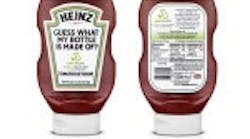Packaging innovation is a hallmark at Heinz, which introduced the first individual foil ketchup packets in 1968, followed by the first squeezable plastic ketchup bottle in 1983 and the first upside-down ketchup bottle in 2002.
You can read about Heinz's Dip and Squeeze ketchup in several places on FoodProcessing.com
- New Food Product Introductions: Heinz Dip and Squeeze Ketchup Now Available in Retail Stores
- New Food Product Introductions: Catching Up With Heinz Through Dual-Function Packaging
- Food Processing Picks: Our Favorite Food and Beverage Products of 2010
- Packaging Awards: Sustainability Wins in 2011 DuPont Packaging Awards
But in the past two years, Heinz has launched two packaging innovations in the company’s iconic ketchup that company executives think could be game-changers.
One dates back to 2010, with the introduction of the Dip & Squeeze foodservice packet. Consumers can either tear off the tip of the package and squeeze ketchup onto French fries or other foods, as they do with traditional sachets, or they can peel back the lid so those fries can be dipped into the ketchup.
Dip & Squeeze, which resembles a Heinz ketchup bottle, also holds three times more ketchup than standard packets. It may seem like a small advance, but the packet has led to increased consumption of French fries at the quick-service restaurants that have been using Dip & Squeeze, according to Heinz, whose customers for Dip & Squeeze now include Wendy’s, Chick-fil-A and Dairy Queen.
The next audacious step was taken this year with the introduction of a retail version of Dip & Squeeze, which reached store shelves in the summer. Would you pay for ketchup packets? A lot of home-packed lunches and on-the-go meals require the condiment, so Heinz officials believe consumers are willing to pay $1.99 for 10 packets of Dip & Squeeze.
The other packaging milestone was the conversion of 20-oz. ketchup bottles in the U.S. to packaging using PlantBottle technology, which was developed by Coca-Cola Co. and is licensed to Heinz through a strategic partnership. It is a PET bottle with up to 30 percent of the material coming from a renewable source – plants – unlike traditional PET bottles made from non-renewable fossil fuels.
Heinz Chairman, President and CEO William Johnson joined Muhtar Kent, chairman and CEO of Coca-Cola, for the formal announcement last February. By the summer, Heinz had converted 120 million Heinz Ketchup bottles to PlantBottle packaging with plans to expand the innovation next to Europe.
Heinz spokespeople wouldn’t elaborate, but look for more from that partnership in the future.
“Heinz made a decision three years ago to lead with innovation,” says Michael Okoroafor, who led the development of Dip & Squeeze as vice president of global packaging innovation and execution. Okoroafor’s job is to extend that innovation mandate to packaging.
Although he technically has an office in the suburban Pittsburgh Innovation Center, Okoroafor was in Italy when we spoke on the phone. He was there working on packaging for child nutrition products, including new single-serve packages, changes in packages for maturing babies and packages that will make feeding more convenient for mothers there.
Okoroafor travels the globe to fine-tune Heinz packaging in all the company’s markets and share the best ideas from the Company’s operations around the world. He also deploys others from the R&D team in Pittsburgh, as needed, to share their packaging expertise with Heinz businesses in other countries. He also sits on the Walmart Sustainable Value Network.
The PlantBottle packaging, he says, “will be transformational. It will be introduced to different brands and in different markets,” although he says Heinz cannot move faster than the supply of the material.
A similar development is under way with meal trays, such as those used by Weight Watchers Smart Ones and T.G.I. Friday’s. Up to 40 percent of the petroleum-based plastic used in the trays is being replaced with mineral-based extenders, such as calcium carbonate. Heinz has also introduced foodservice single serve packets that utilize plant material.
Heinz is also focused on reducing solid waste through packaging that requires less material. To that end, the use of flexible packaging is increasing. For example, Weight Watchers Smart Ones traditionally have been boxed meals with a tray inside. The new bagged meals are in film pouches. And during our visit to Pittsburgh, we saw some prototype stand-up pouches for ketchup – the lower-cost packaging could lower the price of the product.
Out of necessity, packaging has to be considered on a local basis. Certain forms of packaging work well in developed countries with large trucks and refrigerated supply chains. Developing countries with very different supply chains and in-home storage (refrigeration) require very different types of packaging, as well as package sizes.
Okoroafor talked vaguely about European-origin packages that appealed to consumer ideas of freshness and minimal processing. He wouldn't specify but promised, "We’re going to bring that to North America in a big way."


